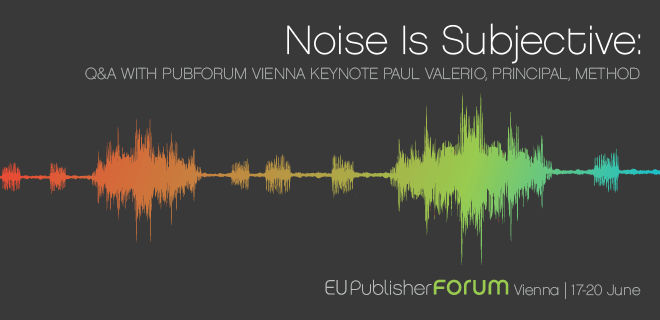
With this year’s only European Publisher Forum rapidly approaching (June 17-20) US Editor and Led Zepplin enthusiast Gavin Dunaway sat down with one of our fantastic keynote speakers – Paul Valerio, Principal at Method – and picked his brains on what he’d be covering in Vienna. Have a read below as Gavin and Paul pick through what he’ll be covering in Vienna as well as a host of other topics.
So you got some insight, do you? Can you explain what Method’s Customer Insight team is focused on these days, and describe your responsibilities?
Most of what we’re doing now is in the area of digital interfaces and multiple screens – figuring out how the different user contexts change the prioritization of features and navigation. Overall, my group tries to align the needs of the client’s business, their brand, and their target audiences, and then turning all those requirements into some kind of coherent direction for Method’s creative team.
You say that publishers and advertisers have more data than they realize, but is there an easy way to distinguish noise from nuggets?
The key is being willing to at least explore the counter-intuitive. You need to step back far enough so you can see if there are patterns involved that go beyond the specific set of metrics you’re most concerned with. Noise is a very subjective term.
The hard part is really accepting that your target audience has so much other stuff on their minds than your ad or content. That humility is the best starting point, because chances are, your competition isn’t going to be watching those non-intuitive areas. As long as you realize that a lot of what you look at will indeed be noise for you, the process of looking will make you smarter in the long run.
There’s a lot of hubbub about data visualization these days – how important is the technique in your work? And how can pub ad ops use it to their advantage?
I work for a creative services company. Most of the people who work at Method are designers of some kind. That means they’re not big fans of quantitative analysis in general. So, I have a lot of experience in communicating very number-heavy ideas to people who don’t want to look at numbers. That means data visualization, so yes, that’s a huge part of my job. And it’s not just designers – all people take in far more visual information than from any other of their senses, so that’s the largest bandwidth channel to get an idea across.
For ad pub ops people, they have so many numbers to deal with; they have many opportunities to communicate in visual ways. I would recommend ditching Excel for a few days, and work on what concepts are behind the quantities they deal with.
Besides the specific magnitude of the numbers they’re trying to communicate, what’s the value of the idea behind that number? What relationship is there between the other metrics they deal with? What would be a metaphor for that relationship that anyone would understand? From thinking in those ways, you can start to form data visualizations that are very powerful in their ability to communicate what’s really important about the data they collect.
What are the most significant ways the digital ad marketplace – and great data spillover – has affected brand management? How can publishers take advantage of this change?
That’s what I hope to find out at the conference. I’m not an expert in digital advertising, which is one reason why [AdMonsters Content Czar Rob Beeler] invited me to speak – to provide that outside perspective. From a brand management perspective, most clients I’ve come in contact with are doing their best to catch up to the greatly accelerated pace of brand communication that is now the norm for digital platforms.
Traditionally, brand management has been in a strict broadcast model – we talk, the customers are supposed to listen. Now it’s much more of a conversation, and most companies do not have the infrastructure to communicate that way. Anything ad publishers can do to help their clients with that communication would be very welcome.
Riffing off a recent Method 10 X 10 piece, can you briefly explain how the idea of an “overture” works in brand management?
The biggest advantage of thinking about overtures is in the realization that people need the transition zone to understand what you’re talking about – don’t start yammering at them right from the start, whether that’s in real world environments or on a digital platform. Sometimes the old ideas still work. Broadway producers knew that people were coming in off the subway, still getting a drink or in the bathroom, and they needed something other than flashing the house lights on and off to prepare people for the show. So they came up with the overture as the level-setter for the entire audience.
That transition zone was really effective for both the people who were new to the show, and for their repeat customers. When you extend that metaphor to retail, hospitality, and digital environments, it still holds up. It comes back to that idea of humility; that maybe people have other things on their minds than your brilliant content, and you need to make it worth their while to pay attention.
 |
Join Publisher Ad Operations and Ad Tech leaders from across Europe for this unmissable 3-day forum. Register today for 2012’s only European Publisher Forum, June 17-20, Vienna. |